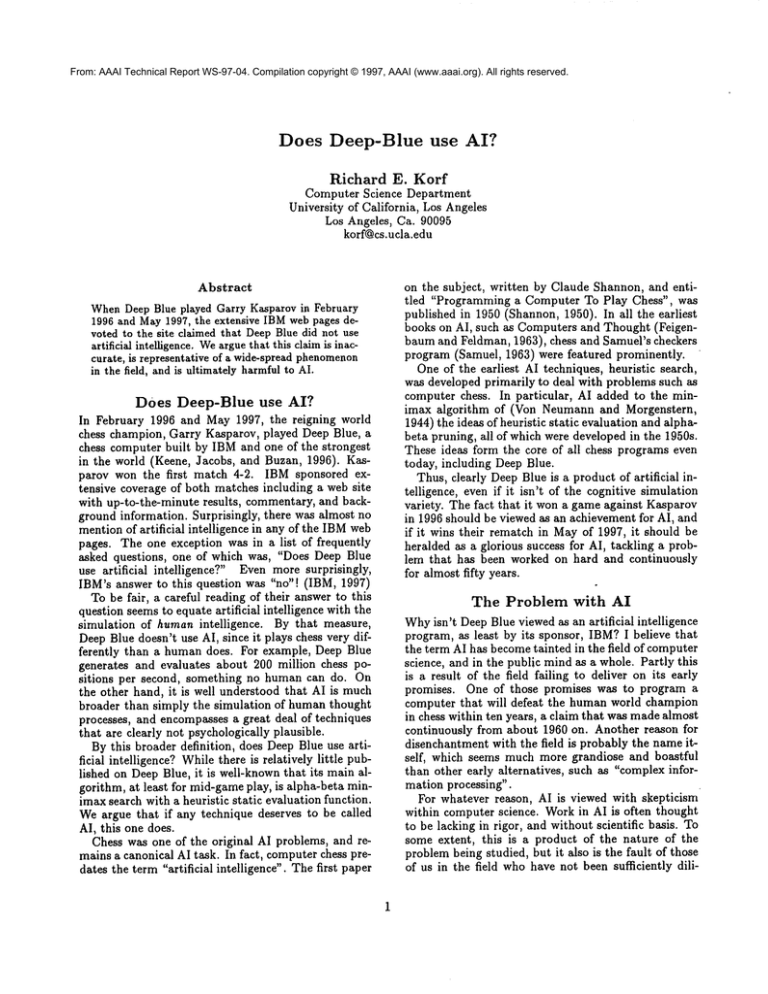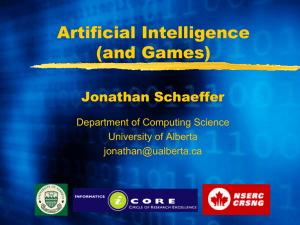
From: AAAI Technical Report WS-97-04. Compilation copyright © 1997, AAAI (www.aaai.org). All rights reserved.
Does
Deep-Blue
use AI?
Richard E. Korf
Computer Science Department
University of California, Los Angeles
Los Angeles, Ca. 90095
korf@cs.ucla.edu
Abstract
WhenDeep Blue played Garry Kasparov in February
1996 and May1997, the extensive IBMweb pages devoted to the site claimed that DeepBlue did not use
artificial intelligence. Wearguethat this claimis inaccurate, is representative of a wide-spreadphenomenon
in the field, and is ultimately harmfulto AI.
Does Deep-Blue use AI?
In February 1996 and May 1997, the reigning world
chess champion, Garry Kasparov, played Deep Blue, a
chess computer built by IBMand one of the strongest
in the world (Keene, Jacobs, and Buzan, 1996). Kasparov won the first match 4-2. IBMsponsored extensive coverage of both matches including a web site
with up-to-the-minute results, commentary, and background information. Surprisingly, there was almost no
mention of artificial intelligence in any of the IBMweb
pages. The one exception was in a list of frequently
asked questions, one of which was, "Does Deep Blue
use artificial
intelligence?" Even more surprisingly,
IBM’s answer to this question was "no"! (IBM, 1997)
To be fair, a careful reading of their answer to this
question seems to equate artificial intelligence with the
simulation of human intelligence.
By that measure,
DeepBlue doesn’t use AI, since it plays chess very differently than a human does. For example, Deep Blue
generates and evaluates about 200 million chess positions per second, something no human can do. On
the other hand, it is well understood that AI is much
broader than simply the simulation of human thought
processes, and encompasses a great deal of techniques
that are clearly not psychologically plausible.
By this broader definition, does Deep Blue use artificial intelligence? While there is relatively little published on DeepBlue, it is well-knownthat its main algorithm, at least for mid-gameplay, is alpha-beta minimax search with a heuristic static evaluation function.
Weargue that if any technique deserves to be called
AI, this one does.
Chess was one of the original AI problems, and remainsa canonical
AI task.Infact,computer
chesspredatestheterm"artificial
intelligence".
Thefirstpaper
on the subject, written by Claude Shannon, and entitled "Programming a Computer To Play Chess", was
published in 1950 (Shannon, 1950). In all the earliest
books on AI, such as Computers and Thought (Feigenbaum and Feldman, 1963), chess and Samuel’s checkers
program (Samuel, 1963) were featured prominently.
One of the earliest AI techniques, heuristic search,
was developed primarily to deal with problems such as
computer chess. In particular,
AI added to the minimax algorithm of (Von Neumann and Morgenstern,
1944) the ideas of heuristic static evaluation and alphabeta pruning, all of which were developed in the 1950s.
These ideas form the core of all chess programs even
today, including Deep Blue.
Thus, clearly DeepBlue is a product of artificial intelligence, even if it isn’t of the cognitive simulation
variety. The fact that it wona game against Kasparov
in 1996 should be viewed as an achievement for AI, and
if it wins their rematch in Mayof 1997, it should be
heralded as a glorious success for AI, tackling a problem that has been worked on hard and continuously
for almost fifty years.
The Problem with AI
Whyisn’t DeepBlue viewedas an artificial intelligence
program, as least by its sponsor, IBM?I believe that
the term AI has becometainted in the field of computer
science, and in the public mind as a whole. Partly this
is a result of the field failing to deliver on its early
promises. One of those promises was to program a
computer that will defeat the human world champion
in chess within ten years, a claim that was made almost
continuously from about 1960 on. Another reason for
disenchantment with the field is probably the name itself, which seems much more grandiose and boastful
than other early alternatives, such as "complex information processing".
For whatever reason, AI is viewed with skepticism
within computer science. Workin AI is often thought
to be lacking in rigor, and without scientific basis. To
some extent, this is a product of the nature of the
problem being studied, but it also is the fault of those
of us in the field whohave not been sufficiently dili-
gent in applying rigorous scientific standards to our
work. The Deep Blue project, and these highly visible
matches, are viewed as marketing tools by IBM. It’s
no surprise that they would want to associate it with
positive images, and avoid labels such as AI that have
come to have a negative connotation in the public eye.
While IBM’s mischaracterization of Deep Blue is a
highly visible example of this phenomenon, it is by
no means the only one. I believe that it has become
commonplacefor researchers and practitioners in areas that were once viewed as AI to distance themselves from the field, and particularly the term "artificial intelligence". Part of this. is a result of simply the specialization of subfields of AI. Fields such as
expert systems, computer vision, speech understanding, natural language processing, robotics, machine
learning, planning, and knowledgerepresentation, all
of which started out as part of artificial intelligence,
now have their own conferences and journals. Furthermore, manyresearchers in these subfields associate
themselves with the subfields, and don’t view themselves as AI researchers anymore.
To a large extent, the fact that artificial intelligence
has spawned so many successful subfields that have
reached critical mass is a success story for AI. The
problem comes when the successful intellectual
offspring of the field disown their parents. Every field
has its successes and failures. If the successful subfields migrate awayfrom the parent field, forming their
ownsubfields, and the researchers in those fields don’t
consider themselves part of AI anymore, but associate
with the subfield instead, the field of AI is left only
with its failures, and newly emerging subfields, which
have yet to demonstrate their promise. The result is a
negative image of the AI field, both in the public eye
and within computer science, an image under which it
continues to suffer unfairly.
The best example of this phenomenonis the field of
expert systems. Originally, expert systems was viewed
as a subfield of artificial intelligence, but is nowviewed
as a separate field in itself, particularly by the people
who build expert systems. Expert systems are by far
the most important and widespread practical applications of artificial intelligence. See, for example, (Winston and Prendergast, 1984).
Interestingly,
the IBMweb pages give some credit
to expert systems for the success of Deep Blue. What
they cite as evidence of this is the program’s opening
book of moves. Clearly, this is an important knowledge base in the program, but it is simply a rote table
of moves, rather than a set of rules. Furthermore, the
opening book is only used for the first few moves of
the game, after which the program must rely on its
alpha-beta minimax search coupled with its heuristic
static evaluation function. Modern high-performance
game programs have little in commonwith expert systems. In spite of this, IBMgives credit to this technology, presumably because the term "expert systems" is
more palatable to the general public than the term "artificial intelligence", and better knownthan the term
"heuristic search".
What to do About it?
Havingidentified this problem, the more difficult question is what to do about it. Changing the name of the
field isn’t a solution. The nameis too well entrenched,
having been around since the Dartmouth conference in
1956. In any case, the original connotations of the label
eventually are lost and replaced by the connotations of
the field itself. For better or worse, the image of the
label "artificial intelligence" will be based primarily on
the advances and ongoing research in the field that it
refers to.
The only solution that comes to mind is a vigorous
effort of education both within the field of computer
science and among the public as a whole. This education should be aimed at making people aware of the
successes of the field of AI and of the fields that have
spun off from it. For example, we should reclaim computer chess as a classic AI problem. At some point,
I believe that a chess machine will defeat the human
world champion, and when that happens, it should be
a public relations bonanzafor the field of artificial intelligence, rather than someother field or organization.
Acknowledgements
This work was supported by NSF Grant I1~I-9119825.
Manythanks to Michael Dyer for his insightful comments on an earlier draft of this manuscript.
References
E. Feigenbaum and J. Feldman (Eds.), Computers
and Thought, McGraw-Hill, NewYork, 1963.
International
Business Machines, Deep Blue FAQ,
http://www.chess.ibm.com/meet/html/d.3.3a.html#ai,
1997.
Keene, R., B. Jacobs, and T. Buzan, Man v Machine:
The ACMChess Challenge: Garry Kasparov v IBM’s
Deep Blue, B.B. Enterprises, Sussex, 1996.
Samuel, A.L., Somestudies in machine learning using the game of checkers, in Computers and Thought,
E. Feigenbaum and J. Feldman (Eds.), McGraw-Hill,
NewYork, 1963, pp. 71-105.
Shannon, C.E., Programming a computer for playing
chess, Philosophical Magazine,Vol. 41, 1950, pp. 256275.
Von Neumann, J., and O. Morgenstern, Theory of
Gamesand Economic Behavior, Princeton University
Press, Princeton, N.J., 1944
Winston, P.H., and K.A. Prendergast, The AI Business - CommercialUses of Artificial Intelligence, MIT
Press, Cambridge, MA, 1984.




